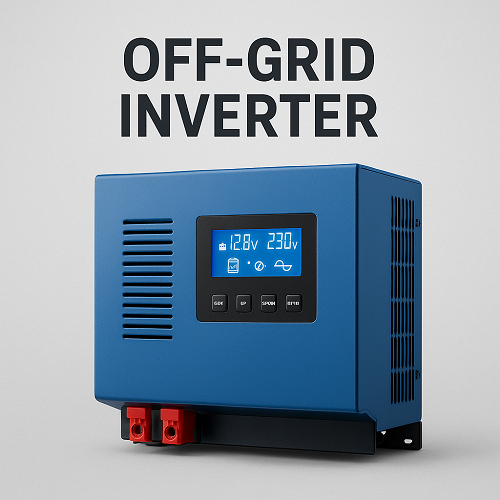An Off-Grid Inverter is a critical component in standalone power systems, designed to convert direct current (DC) from solar panels, wind turbines, or batteries into alternating current (AC) for use in homes, businesses, and industrial operations that are not connected to the main electrical grid.
It ensures a continuous, stable power supply even in remote locations or during grid outages, enabling users to achieve true energy independence.
Product Functions and Uses
The primary function of an off-grid inverter is to convert stored DC power from batteries into AC power compatible with household or industrial appliances.
Beyond simple conversion, modern inverters integrate intelligent energy management and protection systems, ensuring efficient and safe power distribution.
Main Functions
- DC to AC Conversion: Converts 12V/24V/48V DC power into 110V/120V/220V/230V AC output.
- Battery Charging (Optional Hybrid Models): Some models can charge batteries via generators or utility input.
- Automatic Load Management: Prioritizes essential loads and prevents system overload.
- Overload, Short-Circuit, and Over-Temperature Protection: Safeguards the system and connected appliances.
- LCD/LED Monitoring Interface: Displays input/output voltage, battery level, and system status.
Common Uses
- Residential off-grid solar systems
- Remote cabins, farms, and mountain homes
- Telecommunication base stations
- RVs, boats, and mobile workstations
- Backup power for small businesses and clinics
- Disaster relief and emergency power setups
Product Features
Modern off-grid inverters incorporate advanced technology and robust design to ensure reliability and efficiency in harsh or remote environments.
Key Features
- High Conversion Efficiency: Up to 95–98%, minimizing energy loss.
- Pure Sine Wave Output: Ensures stable, clean electricity for sensitive devices like computers and medical equipment.
- Wide Input Voltage Range: Compatible with different battery bank configurations (12V/24V/48V).
- Smart Cooling System: Intelligent fan operation maintains optimal temperature and extends inverter lifespan.
- Parallel Operation Capability: Allows multiple units to work together for higher power demands.
- Built-in MPPT or PWM Charge Controller (Optional): Enhances solar power harvesting efficiency.
- Rugged Aluminum Alloy Housing: Corrosion-resistant and suitable for outdoor or industrial environments.
- Remote Monitoring (WiFi/GPRS): Enables real-time system tracking via mobile or web applications.
Product Specifications (Example Model)
| Parameter | Specification |
| Rated Power Output | 3 kW / 5 kW / 10 kW options |
| Input Voltage (DC) | 12V / 24V / 48V |
| Output Voltage (AC) | 110V / 120V / 220V / 230V ±5% |
| Output Frequency | 50Hz / 60Hz selectable |
| Waveform Type | Pure sine wave |
| Efficiency | ≥95% |
| No-Load Current Draw | < 1.5A |
| Protection Features | Overload, short circuit, over-temperature, low/high voltage |
| Operating Temperature | -10°C to 50°C |
| Cooling Method | Intelligent temperature-controlled fan |
| Communication Interface | RS232 / WiFi / GPRS (optional) |
| Dimensions | 420 × 300 × 150 mm |
| Net Weight | 12–20 kg (depending on model) |
User Manual (Basic Operation Guide)
Installation Steps
- Mounting: Install the inverter in a well-ventilated, dry location away from direct sunlight or flammable materials.
- Battery Connection: Connect the inverter’s DC input terminals to the battery bank (ensure correct polarity).
- AC Output Connection: Connect the AC output to the load distribution panel or appliances.
- Solar Input (if applicable): Connect PV panels via the charge controller.
- Power-On: Switch on the inverter and verify all indicators and displays function properly.
Operating Guidelines
- Ensure sufficient battery capacity before starting high-power loads.
- Regularly check wiring and terminal tightness.
- Keep ventilation openings free from dust and debris.
- Do not exceed rated output power to avoid system protection shutdown.
- For long-term storage, disconnect the inverter and fully charge batteries every three months.
Safety Precautions
- Only trained personnel should install or service the inverter.
- Avoid using in wet or explosive environments.
- Always disconnect power before maintenance.
6. Applicable Industries
Off-grid inverters serve a wide range of sectors requiring reliable, independent energy supply:
- Renewable Energy Systems: Solar, wind, and hybrid power solutions
- Telecommunications: Base stations and communication towers
- Agriculture: Irrigation systems, livestock facilities, and remote equipment
- Construction: Temporary power supply on job sites
- Marine & RV Applications: Boats, caravans, and off-road vehicles
- Healthcare & Education: Clinics, schools, and remote learning centers
- Defense & Emergency Services: Field operations and disaster response units
Target Customers
- Solar energy solution providers and installers
- Rural electrification and microgrid developers
- Off-grid homeowners and eco-resorts
- RV, marine, and mobile workstation manufacturers
- Industrial and agricultural operators in remote regions
- Backup power distributors and system integrators
The Off-Grid Inverter represents a cornerstone technology in sustainable and independent power systems.
With its high efficiency, durability, and smart control capabilities, it empowers individuals and industries to achieve energy autonomy—anywhere, anytime. Whether used in a rural cabin, a telecom station, or an emergency power setup, an off-grid inverter ensures reliable electricity, uninterrupted performance, and peace of mind.
































